![Image: Fish ponds in the East Kolkata Wetlands – the largest sewage-fed aquaculture system in the world today. Source: Edwards, 2008. [^8]](https://solar.lowtechmagazine.com/2021/03/urban-fish-ponds-low-tech-sewage-treatment-for-towns-and-cities/images/dithers/edwards_2008_dithered.png)
After we eat and drink, we excrete into toilets, which use water to flush our effluent into municipal sewage systems. By and large, the resulting sewage is either untreated, or treated in different kinds of wastewater treatment plants, the most advanced of which are expensive to run and have high energy demands. 1
But even if sewage is treated, effluent is still high in levels of nitrogen, phosphorous, dissolved oxygen, and biological matter—essential nutrients for life on Earth. This causes eutrophication. The high levels of these nutrients lead to algal blooms, which in turn may produce toxins leading to mass fish deaths and biodiversity loss in rivers, lakes, and oceans. 2
Essentially, the core of the issue is that rather than nutrients being recycled, as occurs in most ecosystems, it’s a one-way flow. Fixing these problems by, for example, making water use more efficient, or using more energy-intensive sewage treatment plans, doesn’t solve the root of the problem: the nutrient cycle is leaky. And you can’t fix a leaking sink by changing the amount or kind of water you use.
Too much of a good thing
If we want to fix the leaking sink, we need to move away from the idea that human waste is inherently toxic, or that human activity is always bad for the environment. This way of thinking is grounded in the assumption that humans are somehow separated from nature. The logical conclusion of this assumption, then, is to separate us from natural cycles even more: building more refined, chemically and energy-intensive sewage treatment, building hard boundaries between food production and watersheds, and, failing that, using large-scale geoengineering experiments to clean our rivers.
But the main issue here is not that we are somehow toxic and so a burden to our environment. It’s that the nutrients we are releasing into the environment are too highly concentrated. This is especially the case when it comes to the “problem” of eutrophication. Caused by high-nutrient wastewater and agricultural run-off, it is generally thought as a bad thing. But consider the Greek root of the word: “becoming well fed.”
The main issue is not that we are somehow toxic and so a burden to our environment. It’s that the nutrients we are releasing into the environment are too highly concentrated.
Eutrophication is only bad because good nutrients like nitrogen, carbon, and phosphorous, necessary for the majority of biotic life, are too concentrated—causing rapid algal growth, leading to too little oxygen in the water, as well as too many toxins produced by algae, both of which are deadly to fish. However, fish eat algae, so if algae growth were to be slowed down a bit, fish populations would multiply instead. The problem is not that wastewater is polluted, but that there is too much of a good thing, too highly concentrated for the ecosystem to absorb.
How to fix a leaking sink
I first learned about the system of treating sewage through aquaculture when I lived in Hanoi. There, I found out that it’s actually very common, especially in poor agricultural communities, to reuse human waste for production.
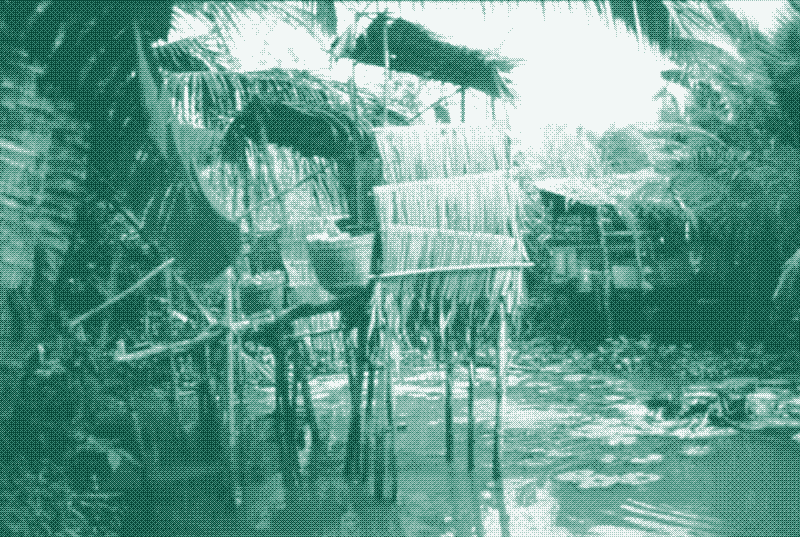
In countries like Vietnam and Indonesia, toilets are often placed above fish ponds. Human and livestock waste may also be collected manually and put in fish ponds. Why? Stimulated by the added nitrogen, phosphorous, and carbon, algae and phytoplankton grow rapidly and start breaking down the nutrients and bacteria and produce oxygen. As oxygen levels go up, fish are able to swim in the water and eat the algae and phytoplankton. Then the fish are caught and sold on the market. Finally, when the pond is drained, fish droppings and any remaining sediments can also be used to fertilize surrounding crops, like rice or fruit trees.
In China, the use of excreta in agriculture and aquaculture has a tradition of centuries. During the communist period, many fish farmers had limited access to fish feed and local state cooperatives started organizing human waste collection systems. Eventually, in many Chinese cities, up to the 1990s, trucks and boats collected human manure in cities—some run by the state and some clandestine, illegal operations—and transported them to aquaculture operations in peri-urban land. From 1952 to 1966, about a third of fertilizers (which includes fish feed) used in China came from nightsoils, and by 1966, 90% of excreta were recycled. 3 Incidentally, today, massive seaweed production off the coast of China has likely greatly reduced the likelihood of eutrophication—an accidental form of bio-remediation and nutrient recycling. 4
![Image: Sewage water being pumped into a fish pond in the outskirts of Hanoi, Vietnam. Source: Edwards, 2005. [^15]](https://solar.lowtechmagazine.com/2021/03/urban-fish-ponds-low-tech-sewage-treatment-for-towns-and-cities/images/dithers/fish-pond-hanoi_dithered.png)
![Image: Wastewater after treatment in fishponds, Hanoi. Source: Edwards, 1996. [^5]](https://solar.lowtechmagazine.com/2021/03/urban-fish-ponds-low-tech-sewage-treatment-for-towns-and-cities/images/dithers/Edwards_1996_dithered.png)
One interesting large-scale example is the system that emerged in the outskirts of Hanoi in the 1960s. Hanoi, the capital of the newly independent communist nation, fighting a drawn-out war against Western occupying forces, had no municipal wastewater treatment. Sewage led out into two rivers, which flowed south and eventually merged with the Red River.
During the communist period of collectivization of farmland, Vietnamese farmer cooperatives were excluded from the international market and so often used whatever resources available to them to feed fish, such as slaughterhouse wastes or spoiled grains. Seeing the untreated wastewater in the canals—a resource out of place—farmers started pumping it into large ponds.
Seeing the untreated wastewater in the canals—a resource out of place—farmers started pumping it into large ponds.
After trial and error, and investing the little they had in infrastructural improvements, they determined the right sewage-and-freshwater ratio needed that would dilute the wastewater enough so the fish wouldn’t die.
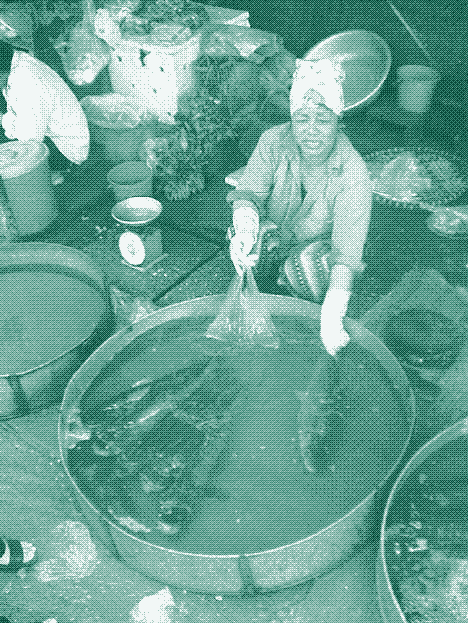
Farmers also grew plants such as water hyacinth to reduce the erosion of the banks, and which could then be fed to livestock. These also had the benefit of drawing out heavy metals from the water. They also practiced fish polyculture, where species like catfish, carps, and tilapia were farmed together, and thus were more effective in cleaning the water and protecting small fry from predators. Every year, the ponds were drained, and the sludge at the bottom was then applied to nearby fields, further reusing available nutrients.
Eventually, these farmers developed a system that, by 1995, provided 40-50% of Hanoi’s total fish supply every year. Scientific measurements showed that the water from the fish ponds, when pumped back into the river, was well below the World Health Organisation’s recommended level for biological oxygen demand—an indicator to determine the efficiency of water treatment systems. 5 Essentially, they had created a water treatment plant for a city of 1.5 million people, at almost no cost to the state.
A “low-cost folk technology” serving an entire city
You might be thinking: sure, this is one example of an interesting, but ultimately doomed, alternative to wastewater treatment. It is an aberration, and couldn’t possibly be maintained for long. Unfortunately for your internal cynic, it actually can be. The city of Kolkata (formerly Calcutta), India—population 14.8 million—has the largest sewage-fed aquaculture system in the world. Though farmers had been using sewage to feed fish in different ways since the 19th century, the system became more developed starting in the 1940s.
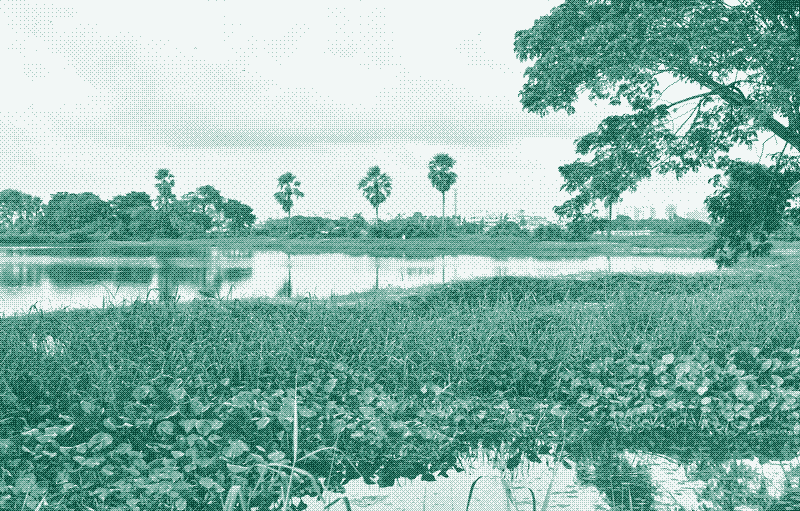
During the British colonial period, administrators built a series of canals through the city that functioned as its sewers. These let out into the Bidyadhari River. However, this river quickly silted up and became unusable. As a result, an adjacent wetland area transformed from tidal salt marshes to primarily freshwater marshes. Two sewage canals were then built in 1940 to further extend the city’s effluent to the ocean. It was at this point that local farmers started rerouting the sewage water into fish ponds in the former salt marshes, growing vegetables on the banks of the sewage canals, and forming cooperatives to manage the wastewater.
Though the Kolkata system was developed over time, it is quite systematic. Every year, ponds are first drained and sludge is applied to fields. Sewage water is fed into the pond slowly at low depth and allowed to sit for two weeks. This basically mimics conventional sewage treatment systems, where sewage is first treated through stimulating algal and bacterial growth, harmful sediments are left to settle, and most parasites are killed because their eggs and worms die if they don’t find a host within two weeks. Then, fish are stocked in another pond, and slowly sewage water is introduced into the pond at a sewage-to-water ratio of 1:4. All of this requires skill and knowledge developed over generations, allowing farmers to know when oxygen levels are too low, which could kill the fish. 3 6 The resulting effluent can reach the water quality of conventional treatment. 7
![Image: A sluice gate made of bamboo at the Eastern Kolkata Wetlands. Water hyacinth is grown to help purify the water and to feed livestock. Source: Mukherjee, 2020. [^6]](https://solar.lowtechmagazine.com/2021/03/urban-fish-ponds-low-tech-sewage-treatment-for-towns-and-cities/images/dithers/sluice-gate-bamboo_dithered.png)
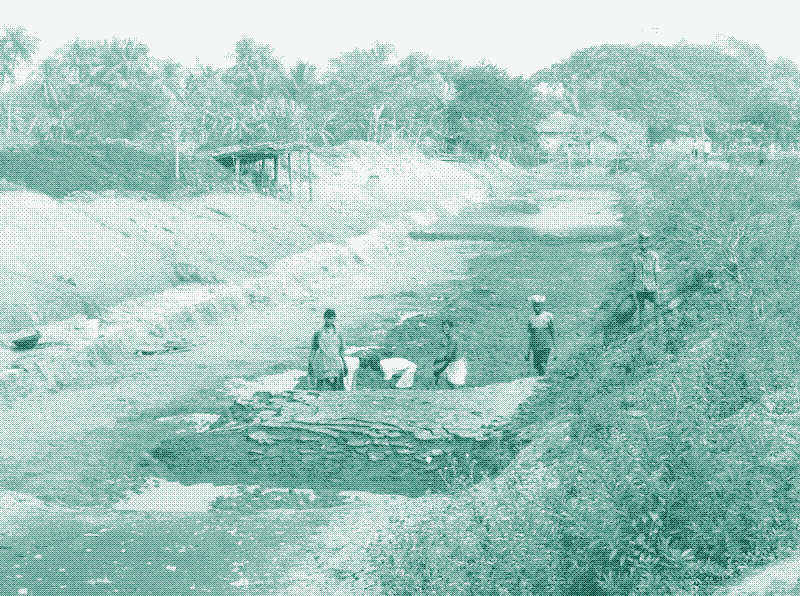
Through trial and error and good judgement, local farmers have developed a wastewater treatment system that is extremely efficient and adaptive to local conditions. They can distinguish the kind of effluent—industrial or domestic—through the hues it gives off, and will control or dilute it when necessary. For example, sewage from tanneries can be toxic to fish, so they will not use it. They vary water levels according to season, weather, and available quantities of effluent. They know the hue of greenish-black the water needs to be to have an optimal oxygen and ammonia level for fish. They can tell whether there is too little oxygen by paying attention to the degree by which fish come up to the surface to gulp air. Farmers harvest snails in the water to protect fish growth, which are then crushed and fed to ducks, whose droppings in turn fertilize fish ponds and nearby soils. They plant water hyacinths and duckweed to absorb heavy metals from the sewage water. 7 8
The Kolkata fish farms provide 40% of the region’s fish production and process 80% of the city’s sewage.
The Kolkata fish farms provide 8000 tons of fish per year to the city, or 40% of the region’s fish production. It processes 80% of the city’s sewage, and reduces the nutrient and organic loads of the city’s sewage water by 50-90%, while keeping bacterial loads to an acceptable level under WHO guidelines. It is calculated to save the city an equivalent of $64,400,000 per year in sewage treatment costs—making Kolkata an “ecologically subsidized city”. 9 The system provides farmers a return over investment of 28% and provides 200,000 people with a livelihood. 10
While profit shouldn’t itself be the goal of this system—it’s a public service, after all—it certainly helps to defray costs of wastewater treatment. In a small municipality in Karnal, northern India, one study showed that municipal sewage-fed fish ponds, installed in the 2010s, provided over $25,000 of net profit per year to the municipality, as well as indirect benefits such as improving nearby soils through the sale of treated wastewater to farmers. 11
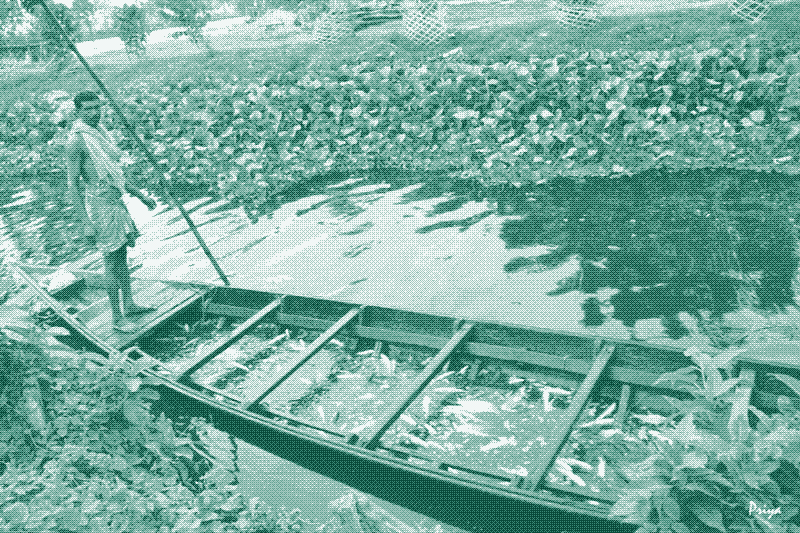
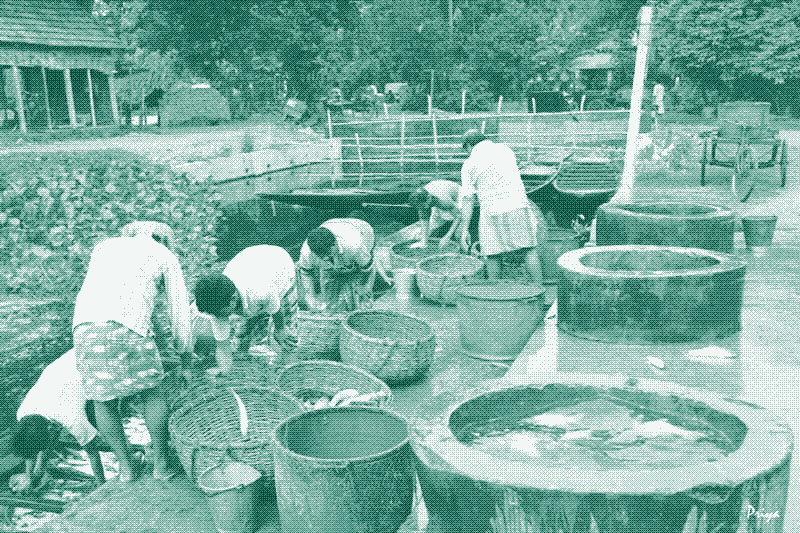
Still, when introduced into small rural communities, the benefits extend far beyond monetary profit, to the social, cultural, and ecological services provided by the fish ponds. This includes improving soil quality, adaptability of local communities to climate change, leisure (e.g. fishing with friends), and steady sources of protein for small-holder farmers. For example, even if they don’t sell the fish, a small sewage-fed fish pond can provide a family of six with 8kg of fish, per person, per year—a significant raise in protein intake for many rural communities. 12 In the case of the Eastern Kolkata Wetlands, the fish ponds also help to recharge the ground water—a serious issue in India where many aquifers are nearing depletion. 13
Kolkata’s wetlands are a “low-cost folk technology” 14 treating the majority of the sewage of a city with a population the size of New York. This is made possible through the development of a vast human-fish-plant ecosystem, a city-scale wastewater treatment plant that emerged through the creativity, ecological knowledge, and direction of local farming communities.
Over 90 systems in Germany in the early 20th century
By this point, your internal cynic might have come up with another counter-argument: sure, so it works at scale. But you would have to be pretty desperate, and poor, to stoop down to farming fish in sewage water. While it might work in India, and worked for a while in Vietnam and China, it would never work in developed countries, where there are higher sanitation standards, and where no one would want to eat the fish farmed in sewage anyway.
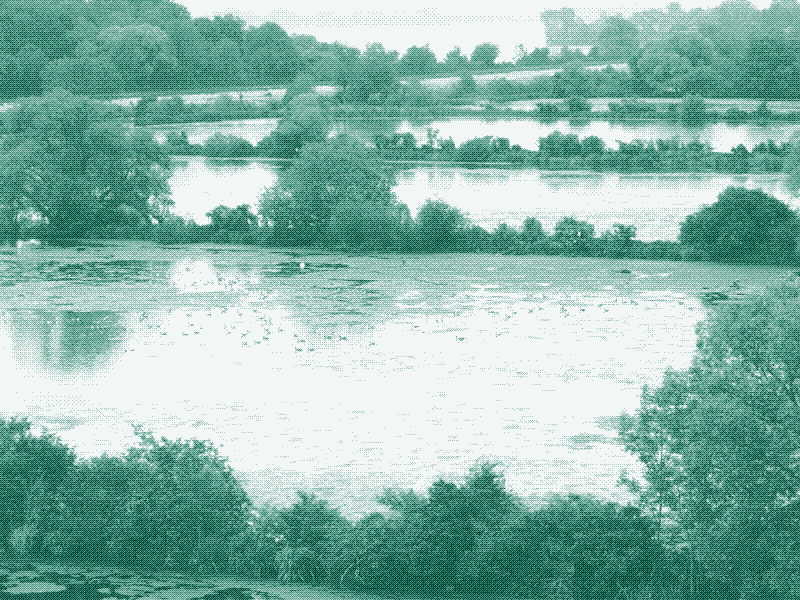
You may be surprised to learn that, in fact, over 90 such systems existed in Germany in the early 20th century. 15 Up until the 1990s, the city of Munich still processed most of its wastewater through fish farming. Indeed, Germany has pioneered some of the more detailed and rigorous scientific investigation into the large-scale viability of sewage-fed fish ponds, as early as the 1890s.
Up until the 1990s, the city of Munich in Germany still processed most of its wastewater through fish farming.
Like in China, wastewater-fed fish ponds have a long but unappreciated history in Europe. Castle moats, monasteries, and villages often had wastewater-fed fish ponds. As cities grew rapidly in the 19th century, untreated wastewater was simply flushed into rivers, leading to the collapse of fisheries across Europe as well as generally unsanitary conditions and the spread of disease. There was a growing recognition that sewage should be treated; one common indicator of adequate treatment methods was that trout are able to live in the treated water. As a result, civil engineers and scientists constructed small fish ponds to test the quality of municipal sewage treatment plants.
Gustav Oesten, a civil engineer charged with wastewater treatment in Berlin, began to experiment in the late 1880s with using fish to treat wastewater, and to harvest fish as a secondary product of sewage treatment. He was able to spend the good part of a decade conducting experiments with different fish species, designs for ponds, and various local and weather conditions. 15
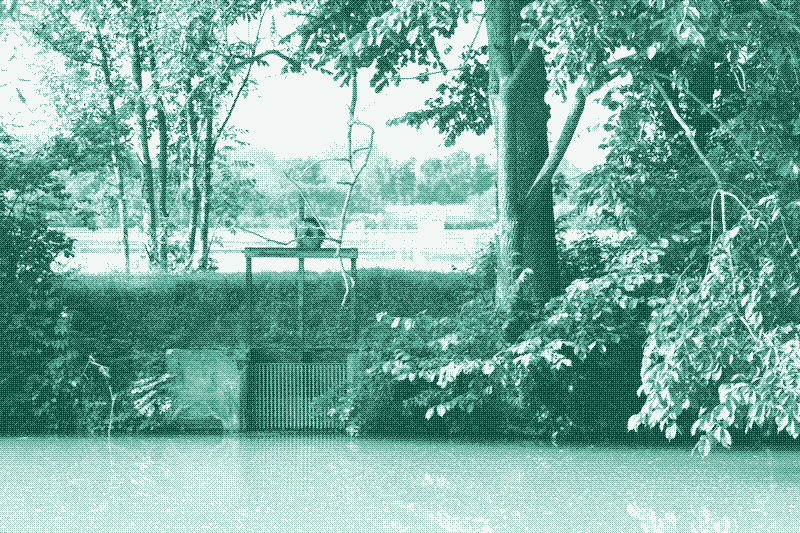
Through these experiments, he showed conclusively that fish growth accelerates in sewage water, and that fish in turn help purify sewage water. Trout were not very good fish for this purpose, because they cannot tolerate water with high oxygen levels—common in wastewater systems, a byproduct of rapid algae growth. Carp, who can come up for air when oxygen levels are intolerable, grew very well—those fed with sewage far exceeding production of those in normal fish ponds. But, using trout, he proved that the water was of high enough quality to enter back into the water shed. His experiments suggested that fish ponds could be designed to help address Europe’s water crisis and, at the same time, provide an economic return through the sale of fish.
By the beginning of the 20th century scientists throughout Germany started conducting more small-scale experiments. Bruno Hofer, a fish scientist better known for pioneering the study of fish pathologies, started scaling up these experiments, showing in the early 1900s that wastewater of larger institutions like hospitals, breweries, and factories, as well as smaller municipalities could theoretically be treated with fish ponds. He even went further, and “dared” to propose such a system for a city as large as Munich—a notion that was perhaps considered outlandish at the time.
![Image: A sprinkler introducing secondary treated wastewater diluted with river water into a wastewater-fed fishpond in Munich, Germany. Source: Edwards, 2005. [^15]](https://solar.lowtechmagazine.com/2021/03/urban-fish-ponds-low-tech-sewage-treatment-for-towns-and-cities/images/dithers/sprinkler-fish-pond_dithered.png)
By 1929, however, after several successful implementations of Hofer’s design around Germany, the city of Munich built its own fish pond wastewater treatment system, which served the whole city until the 1990s. This was the largest such system implemented at the time in the world, initially designed to process the wastewater of 500,000 people. The system was so efficient that the water leaving the ponds, fully treated, was comparable to natural water in quality and nutrient level. 16
Many applications
As these examples illustrate, sewage-fed aquaculture is a solution to many interlinked problems. It processes waste—from agriculture, livestock, and cities—and cycles those nutrients back into the system through food and agricultural production. It reduces nitrogen and phosphorous levels in the water, preventing eutrophication further downstream. It reuses available water, slowing down the water cycle and replenishing groundwater. It further reduces unnecessary inputs like chemical fertilizers, phosphates, and energy-intensive fish feed. Finally, it creates jobs and a source of income, especially necessary in poor countries.
If we were to calculate the fertilizer potential of sewage water alone, this would be reason enough to develop systems to reuse it. For example, one study estimated that, in the year 2000, all of India’s sewage was worth an equivalent of $2,000,000 per day in fertilizer costs. 17 In other words, on any given day, all of India is flushing several million dollars down the toilet. Waste-fed fish ponds would be of great help in capturing this wealth. Perhaps counter-intuitively, scientists have found that waste-fed fish ponds may actually be especially useful for arid countries, where water is scarce, by re-using wastewater for protein production. 18 Fish ponds don’t have to be for productive use alone. They can be integrated into wetlands and conservation areas, leisure fishing, tourism areas, or educational sites. They provide opportunities for improving biodiversity and making urban life more permeable for nature.
Fish ponds don’t have to be for productive use alone. They can be integrated into wetlands and conservation areas, leisure fishing, tourism areas, or educational sites.
Another reason waste-fed fish ponds continue to be relevant is that it is low-cost and low-tech, and therefore has little barriers for implementation. While high-tech, high-input systems like hydroponics, vertical gardening, and automated agriculture are getting a lot of press these days, the fact is that the majority of the world’s farmers have little to no access to capital and relies on small, but mostly sustainable, interventions to feed a stunning 70% of the global population. 19 Waste-fed fish ponds offer a source of subsistence at little financial risk to these small farmers. 8 Equally, when developed at the municipal level, they offer small towns, villages, and resource-poor communities opportunities to defray the costs of wastewater treatment, as well as generating local employment and improving sanitation. 11 12
Why don’t we do this more often?
Despite many advantages, most sewage-fed aquaculture systems have either been totally stopped or are in decline. So what happened? The first possible reason, and the one that most people might raise, is the “yuck factor”. Perhaps it’s just too gross for most people to eat fish grown from poop. By and large, this wasn’t the problem: consumers’ surprising acceptance of waste-fed fish is a constant in the research on urban fish ponds. 20 Furthermore, about 10% of the world’s population probably already consumes food irrigated with wastewater 21, and, even in the European Union, where agricultural regulations are famously strict, many farmers already apply sewage sludge to their fields—but European consumers don’t seem to care too much.
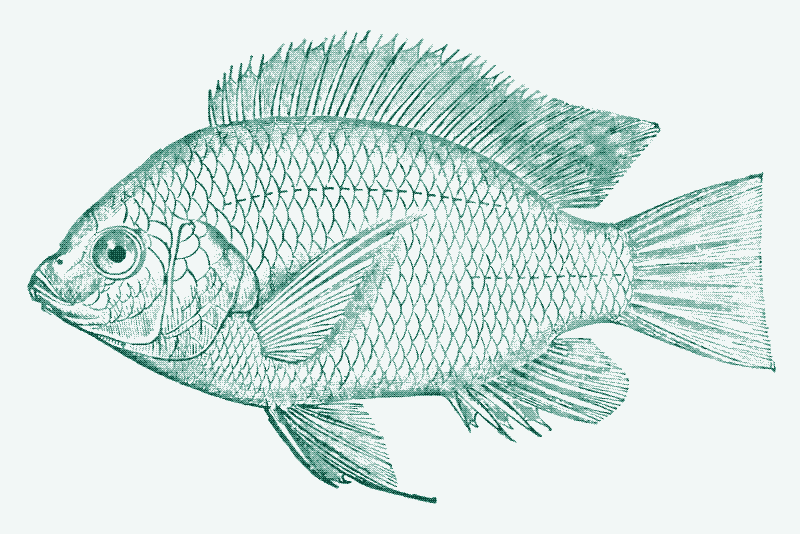
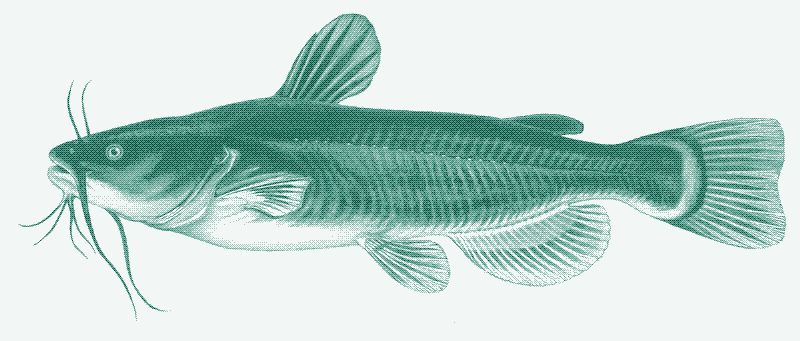
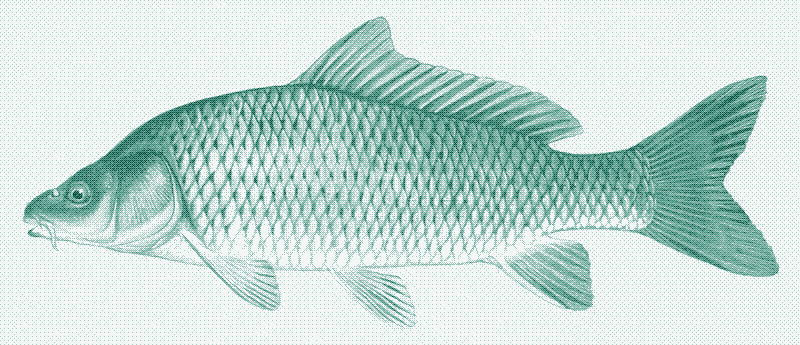
The second possible reason for their decline is that it’s not safe. And, it’s true, here is where the most care needs to be taken in designing effective wastewater treatment. There is good evidence showing that sewage treatment in fish ponds can be as safe as conventional methods. Some of the strongest evidence to support this comes from a city-sized experiment conducted in the 1980s in Lima, Peru, sponsored by the World Bank and the United Nations Development Project. Aid agencies worked closely together with the city government to design a large-scale aquaponic sewage treatment site. 22
The site was basically a city-sized proof-of-concept. Endless measurements were taken over its two decades of operation, adjusting different variables throughout the project’s lifespan, and controlling for changes in volume of sewage and weather. It was found quite conclusively that fish-based sewage treatment was not only a viable and economical alternative for low-income countries, it also met stringent World Health Organization guidelines for water sanitation. The fish were also tested for human consumption. In all three trials, 100% of fish tested were rated at “very good” in safety levels. 23 This study wasn’t alone: numerous studies have investigated the safety of fish grown in sewage ponds. 24
More than just a leaking sink
If it’s not the “yuck factor” or safety, then what was it? In Hanoi, the waste-fed fishponds were not fully recognized for their potential, and peri-urban development in the 1990s began to encroach on the fish ponds. As the communist era came to an end, land near the city became increasingly valuable, and ponds were filled up for housing construction. Sewage became mixed with untreated industrial effluent, leading to large amounts of sewage being poisonous to fish, in turn leading farmers to switch to pelleted feed, by then increasingly available as Vietnam’s domestic market was opened to foreign trade.25 26 Today, Hanoi only treats 22% of its sewage, the rest flows directly into its river systems, and 180,000 cubic meters of waste water are discharged every day into the To Lich river, the same river that serviced the fish ponds. 27 28
The disappearance of fish ponds in Germany can also be largely attributed to urban growth. As cities grew, peri-urban areas—where fish ponds necessarily needed to be placed due to them having to be close to sewage lines and sources of fresh water—became more valuable. Pressured by booming real estate prices, less availability of land, high costs of labour, as well as diminishing returns on investment as domestic fish breeding had to compete with international markets, governments inevitably chose to close the fish ponds, or convert them into more conventional sewage treatment plants. Even in Munich, the largest system built in Germany, management was costly and became less and less appealing to the municipality. Munich’s fish ponds were eventually converted into a nature reserve, where migrating birds come to rest. Fish production is no longer its primary goal, and the estuary only absorbs a small percentage of Munich’s wastewater. 15
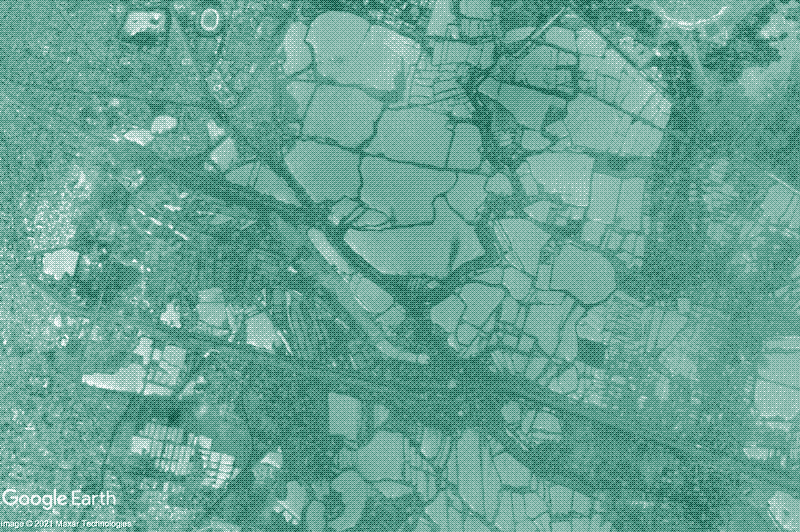
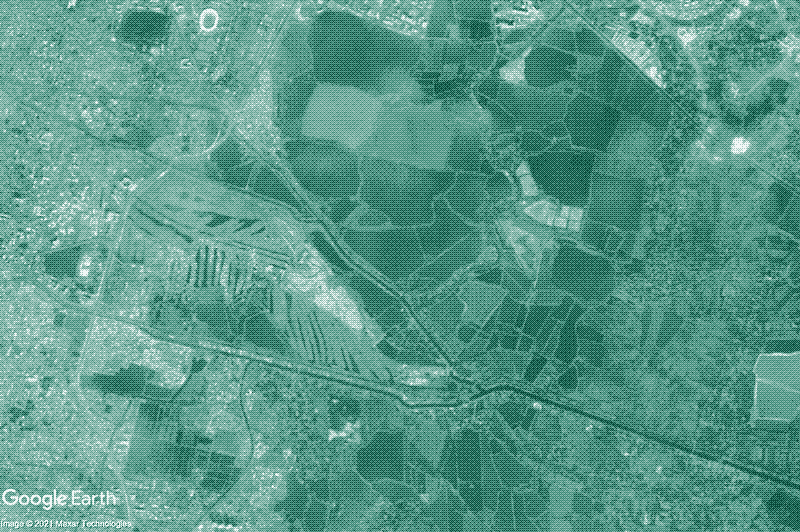
The system at Kolkata is still operational, but suffering from similar symptoms. At their peak, fish ponds in the East Kolkata Wetlands were as large as 12,000 hectares. This has shrunk to 4,000 hectares due to encroaching urban development. In Kolkata, too, workers struggle to deal with industrial effluent such as that from the sizeable leather tanning industry, which is poisonous to the fish and indiscriminately dumped into the municipal wastewater system. 6 10 29 30 Thankfully, unlike Hanoi’s government, the city of Kolkata and the Indian government recognized the importance of this system, and put in a series of regulations to protect it from further development. Still, informal and illegal development—where developers fill up ponds with debris overnight and then build on it as farmers are forced to abandon it—is slowly chipping away at the wetlands.
So the main driver of their disappearance is urban expansion into the peripheries. This is largely due to the global speculation on real estate—which constitutes 60% of all capital investments today. 31 When given a choice between selling peri-urban land to the highest bidder, and pairing sewage treatment with some fish production, most officials won’t think twice—the fish ponds have got to go! A second reason is the high prevalence of toxic chemicals in our water systems—which are too concentrated for ecosystems, and aquaculture systems, to absorb. We should ask ourselves if it’s really worth it to permit these products if they make it harder for us to mend the ecological rift between our settlements and their surroundings.
More messy, organic systems are often derided as backwards and primitive, when in fact they may be far more appropriate and sustainable than the energy-intensive, easily replicable “solutions” valued by planners and engineers.
A third reason is the relatively cheap cost of fossil fuels. In most industrialized countries, it is much more rational to choose for sewage treatment plans with a small land footprint but a large carbon footprint. In a world where energy is cheap, environmental costs can be pushed further and further downstream. But they will eventually circle back to us, and already are. Finally, a significant factor, and one which we shouldn’t ignore, is the bias of our leaders and of professional engineers against more messy, organic systems like that of wastewater-fed aquaculture. Such low-tech solutions are often derided in popular culture as backwards and primitive, when in fact they may be far more appropriate and sustainable than the energy-intensive, easily replicable “solutions” valued by planners and engineers. 32
Each reason points to a deeper problem: our economy’s inability to value the right things. Like so many sustainable solutions today, and many of those discussed on this website, sewage-fed fish ponds suffer from the “you can’t change this one thing without changing the whole system” problem. These systems are beset by global real estate speculation, toxic chemicals in our food and household products, contamination by industry, the cheap price of fuel, and the deep-seated idea that humans are separate from the ecosystems they are embedded in. At the root of it all is a system of value that is not in line with our ecological needs as a species, and as a member of Earth’s living community.
Fish ponds are a low-tech, low-cost, safe, and sustainable way to fix our society’s leaking sink. But when we get down there on our hands and knees, we might find a lot of other things that need fixing.
Thank you to Henning Fehr for doing research on the fish pond system in Germany, Michael DiGregorio for telling me about the Vietnamese system, Phuong Anh Nguyen for the extra research into it, and Geert Vansintjan for always keeping me inspired.
Reactions
To make a comment, please send an e-mail to solar (at) lowtechmagazine (dot) com. Your e-mail address is not used for other purposes, and will be deleted after the comment is published. If you don’t want your real name to be published, sign the e-mail with the name you want to appear.
Reactions
Rajat
A different but related technology is the ‘constructed wetland’, which has been used quite successfully to treat industrial wastewater as well. Thank you for this article, I’m an Indian, and I’d heard about the East Kolkata wetlands, but I’d never read about it in detail. Indeed, ‘urban fish ponds’ are an example of intermediate technology that E. F. Schumacher would have approved of with a smile.
I have just one request: could you do an article on constructed wetlands? You might like the book ‘Constructed Wetlands for Industrial Wastewater Treatment’ by Alexandros Stefanakis, if you decide to write an article on this.
David L
Love your work. Thought you might be interested in this Asparagus at Formby:
https://www.nationaltrust.org.uk/formby/features/asparagus-at-formby
Plus Sewage farms in the UK were famous for tomatoes :-)
You didn’t even need the seed
Take care
Michael B
Hi there
Again a superb idea - only you forget that not all we drop is organic. What about all the chemicals, medicines, heavy metals contained in our shit ?
They did not exist in such quantities when the low tech sewage treatment system was put into effect.
My guess is that if not the fish, then the population eating them would be poisoned if using this system on the sewage of any western City.
Nonetheless, it would be a great idea
Mitch
Good morning,
First, I have to say thank you so much for your unique perspective, I look forward to every issue, and have purchased your paper-based archive for my friends.
I read with interest your historical look-back on fish farming from sewage treatment. I have a few notes I would like to pass along.
https://www.toddecological.com
They also worked with the Chinese provincial governments on Baima Canal to restore it public open space by designing ecological sewage treatment systems. SAD endpoint …The Canal Dredging Lobby ended the project (possibly due to fear of loss of dredging jobs should this eco-technology takeover.)
https://www.cyclifier.org/project/baima-canal-restorer/
https://www.amazon.com/Alcohol-Can-Be-Gas-Revolution-dp-0979043778/dp/0979043778/ref=mt_other?_encoding=UTF8&me=&qid=1617109767
https://www.amazon.com/Solviva-grow-acre-Peace-Earth/dp/0966234901
https://sites.tufts.edu/poweredbypoo/purified-by-plants/
And while all this is great, I have to pose the other issue, not specifically discussed in your article. That of bio-accumulation of a veritable soup of pesticides, flame retardants, Fluorinated compounds (PFOS, PFAS) and heavy metals. In the process of writing my latest book, Detox for Everybody, it became painfully clear we have stuck our foot into the proverbial shit really deeply.
PFCs, having a Fluorine backbone, are particularly difficult to destroy / degrade / metabolize. Having been widely used as fire-suppressants at airports and military bases, the US is finding migration off those sites into streams and municipal sewer systems, then into the Publicly owned sewage treatment works. Here they accumulate in the sludge which in some states gets applied to agricultural land, mostly grazing/ pasture land. The ruminants eat the grasses which have taken up the PFCs from the sewage sludge, and these chemicals bio-accumulate in tissues (see attached graph).
I don’t really know a solution - so far only High temp incineration destroys them. However they have been linked to precocious puberty, infertility, and liver damage and certain tumor types.
My sense here is that a) we need to stop making things the wrong way, and b) perhaps develop plant/bio solution that can transform the Fluorine somehow, perhaps a to crystalline format.
Much admiration and a big hug,
Thanks,
Mitch
Laszlo F
I think the article misses a key financial point: only low market value fish tolerate such an environment. AFAIK carp, rudd, eel are increasingly processed and used in cat & dog food rather than for human meals. Yes - we could eat them, but we won’t, this should indeed be treated as a form of nutrient & fertilizer production, rather than classic fishery. While fish consumption is somewhat constant around the world, it increasingly moved towards saltwater fish from freshwater species (I confess: I prefer saltwater fish as well). So yes - a good biological sewage treatment system rather than something that could yield important agricultural resources, the extra effort is generally not worth it for fish-producing fish ponds.
Thomas Reis
I loved to work for a festival compost toilet company and written extensively about the civilization leak: here a German article how the French used human waste for raising fungi - champion.(Italians still do it) http://energieblogger.at/champions-scheisse-und-das-geheimnis-der-franzoesischen-kueche_3506.html will blog your article!
The Illinoisian
Thank you for this article. As an environmental activist currently working to promote an Illinois law that will slow agricultural nitrate and phosphorus run-off into surface waters and aquifers, I read your descriptions of urban fish ponds with great interest. Though the vast majority of N and P run-off, as well as chemical run-off, comes from Illinois agricultural fields, urban wastewater systems also contribute to this problem.
My question has to do with pollutants that your article did not mention: pharmaceutical drugs. Perhaps the levels of such pollutants are much lower in Asia than in the US, but articles about US water quality often mention the high levels of some drugs in our water systems. Has such pollution been an issue in any other part of the world? And if it has been a problem, have any of these low-tech sewage treatment sites found ways to address that kind of pollution?
A second question relates to viral loads in sewage. In the US I’ve seen a few articles detailing how COVID-19 has been found in local sewage. Has this factor come up in any of your research? How does viral contamination compare with bacterial or fungal levels where the 2-week ‘starvation’ period strategy seems to keep bacteria and fungus from becoming a problem in urban fish ponds? Maybe I’m simply expressing one form of the “yuck factor,” but I’m very curious about these contaminants and the ability of urban fish ponds to address their realities.
Again, thank you for an excellent article. The photos, too, really brought the subject to life. Many of the urban ponds are very beautiful and that was something I did not expect to see.
Your work is appreciated.
Scott
Hi,
Very interesting article. I used to work in an environment protection department. Some of the waste division staff talked about the drugs and chemicals in sewage that were cycling through into the wider ecosystem/landscapes. These included the contraceptive pill, chemotherapy drugs, antibiotics, a load of highly carcinogenic/mutagenic chemicals. I’ve no idea whether in a fish farming system, the fish would end up contaminated from both human excreta and chemicals used in the surrounding landscape and wondered if you could address this.
Thanks Scott.
ET
One point in your article, doesn’t seem to have been thought through - the farmers which fed water-grown plants to their livestock, which also had the “benefit of drawing out heavy metals from the water”.
That’s not a benefit, if you’re feeding the plants to livestock, which humans then eat. Animals and many plants can’t break down heavy metals, or sufficiently excrete them - they’re toxic precisely because they build up in the body. The concentration then increases as you go up the food chain. Growing plants to draw our heavy metals can be good, but putting them into the food supply would slowly poison the people eating those animals.
Peter
You can forget about that idea in modern societies, because psychotropic drugs are for the most part not biodegradeable…
this is even true for potable water from wells beneath rivers.
One would introduce a substance return loop and “treat” even healthy people.
Jim Baerg
Israel Walker: have you read about this guy’s ideas?
https://en.wikipedia.org/wiki/Henry_George
Torcy
Hi,
Another example in France on Atlantic Coast at Rochefort ~20 000 people https://www.station-de-lagunage.fr/en/
It’s also a bird refuge.
Thank you for your work!
Israel Walker
You simply cannot escape the politics.
In Victor Davis Hanson’s “The Other Greeks” (ISBN 978-0520209350) in which the author posits that real backbone of ancient Greek democracy was not the highfalutin words of the intelligentsia, but good stewardship by many small plot owner/operator homesteaders instead of serfs.
The iron age British won independence from Europe largely because of tradition of archery, which was possible there because of long tradition of small plot owner/operator homesteaders instead of serfs.
Or the Dutch ascendancy in 1400’s which was (with a little help from fossil fuels, as you’ve covered) due to the unique land conditions there allowing a long tradition of small plot owner/operator homesteaders instead of serfs.
Or Thomas Jefferson’s intention that the U.S. be a land of yeoman farmers, each with their own small scale, owner operator homestead.
Or the ascendancy of the U.S. in the 19th century because after the genocide and relocation of the native population there were huge timber reserves and a multitude of small plot owner/operator homesteads instead of serfs.
Marx was right about some things and one of them was that the workers should own the means of production. There is no solution but a holistic one, and part of that simply has to be that those who work on and live on the land owns it instead of capitalists.
Aaron Vansintjan
Some responses to the comments:
Thank you Rajat! I came across constructed wetlands and am now considering writing a piece soon about it. Thank you for the book recommendation.
–
Thank you David L. This is an extremely funny anecdote.
–
Thank you Michael B for the comment. I would have liked to address this more comprehensively, even though it is already addressed in footnote 25. Some points:
From the studies done, there was little evidence that these chemicals caused problems for the fish. However, these studies were done in (a) low-income countries (b) before the 1990s, when such chemicals were not as prevalent. That being said, there are practical ways around these issues, as recommended by the extensive literature.
Integrated decontamination, e.g., using water hyacinth and duckweed to absorb toxic chemicals.
“lengthening the food chain”, i.e., feeding fish to livestock. This would decrease concentrations of toxic chemicals and ensure that we don’t eat them directly but “dilute” them through the system.
By and large, conventional recommendations apply just as well to this system, for example, making sure that industrial waste is processed on-site, rather than let out in municipal public wastewater treatment systems. This is rarely done in the first place and one of the biggest sources of the problem. Primary and secondary ponds also break down many (but not all) emergent toxic chemicals.
Some countries are trying to do very complex things like use UV radiation to break down chemicals. You can see however that as we increase the complexity of our socio-natural systems, the “solutions” increase in their complexity and energy requirements as well—a running theme on this website.
As is clear, the problem is much deeper. As I say in the article “We should ask ourselves if it’s really worth it to permit these products if they make it harder for us to mend the ecological rift between our settlements and their surroundings.”
For more on this, I highly recommend the following texts:
Edwards, P. (1992). Reuse of human wastes in aquaculture: a technical review. Water and Sanitation Report 2, UNDP-World Bank Water and Sanitation Program, The World Bank, Washington, D.C. 350 pp.
WHO. 2006. Guidelines for the safe use of wastewater, excreta and greywater in agriculture and aquaculture.
Mara, D. (2013). Domestic wastewater treatment in developing countries. Routledge.
–
Thank you Mitch Kennedy for the analysis and links. I’ll look into these, and hopefully they can inspire future pieces!
As noted in my response above, bioaccumulation of emergent chemicals is a serious issue. My above comments also apply here. As you note even conventional systems are having trouble dealing with these chemicals. A serious rethink of how we approach health and industrial production is of course necessary.
–
Laszlo: Agreed that the finances are increasingly difficult. I had hoped that this was partly addressed in my point near the end about high-energy, high-input industrial agriculture systems. Currently it is simply cheaper and easier to raise fish on industrially-produced fertilizer and “trash” fish, a byproduct of oceanic industrial fishing. There are still cases, however, where this is still economically feasible, as in the Kolkata case.
Even so, there are many things we do as a society that aren’t for the purpose of profit alone; libraries and schools are one example. Likewise, fully recycling our nutrients should ideally be seen as a good, not a commodity. As you say, we should be looking at this as a means to (a) defray costs of wastewater treatment (b) nutrient recycling, rather than a fishery in itself.
–
Thank you Scott, very important point. See my responses to #3 & #4.
–
ET: The problem is more complicated than that. Currently, in the Hanoi case for example, since the fishpond system was stopped, there has been no adequate sewage treatment, industrial or municipal, to speak of. Therefore bioaccumulation and contamination is already the norm.
Because of this, WHO guidelines suggest acceptable levels should be a goal rather than a requirement. This is because for low-income countries, any intervention is better than nothing, which is the status quo. What’s more, there is good evidence to show that bioaccumulation is actually not that serious in these systems, rather, what they seem to do is “dilute” it to more acceptable levels through lengthening the food chain. So, rather than rejecting this system outright, it would make more sense to keep the broader goal in mind (water treatment and recycling nutrients) and encourage cheap and doable interventions to lessen negative impacts (e.g. regulate the same water plants should not be fed directly to livestock or be the main part of their diet, rather, they would need to be used as compost / fodder for crops first, therefore “diluting” heavy metals; treat heavy metals on-site in industrial production; use primary and secondary ponds to “settle” heavy metals when possible).
See especially Mara, D. (2013) (free online) for more on this.
–
Thank you Jim Baerg. I wondered the same, but haven’t found much information on it. Interestingly, since I wrote the article, several people have told me there were some sewage treatment plants in Ontario, Windsor I believe, that used fish. I am curious if they are still around, and how they dealt with the cold weather problem.
There are many solutions for treating sewage, which range from the complex and high-input to less complex and low-cost. By and large, as I understand it, there is a trade-off between high-input and high-cost treatment that take up less space, and low-cost and low-input treatment that takes up a high amount of space. For most countries, allowing the wastewater to settle in primary and tertiary ponds deals with almost all the pathogens and allows the heavy metals to settle, and UV from the sun can break down a lot of the more complex compounds—similar to the anaerobic digester. It is here that the fishpond system might make the most sense, because it has low initial capital investment for the amount of environmental benefits it provides. For high-income countries, more complex systems have diverse benefits, and it may make sense to do capture the methane and burn it to generate electricity. Even then, though, there is still the problem of eutrophication downstream, and fish (or wetlands) could still complement the system.
–
Thanks Illinoisian! Thoughtful reflections and I’m glad you find it interesting for your work. I dealt with some of your question in my response to (3), (4), and (8). I would add this to your specific question about COVID-19.
Fish ponds can be considered one addition to the conventional sewage system, which already involves primary and secondary treatment ponds that retain sewage for at least 2 weeks. This deals with the majority of pathogens, and likely also kills COVID-19 for the same reasons that it kills the common flu, largely through exposure to sunlight in the case of this pathogen. The same recommendations for conventional systems apply to fish pond systems, by and large. The difference between conventional systems and the fish ponds is that they also aid in the recycling of nutrients back into the system rather than causing eutrophication, and, second, can help offset the cost of sewage treatment.
I would also recommend that you read Mara, D. (2013) (free online) if you’re curious for more, the last chapter deals with fish ponds, but the rest of the book is about the science of how to deal with contaminants and pathogens cheaply and effectively.
–
Torcy: thank you, that’s very interesting!
–
Thank you Israel Walker for the interesting comment. I would definitely agree that those who work on and live on the land would own it—just as workers should control the fruits of their labour. Land reform is fundamental to the change we need. I don’t think small landownership necessarily solves all problems, it was also part of what helped build the popular base for the genocide of Indigenous people in the Americas, for example and, coming from the low countries myself, Dutch individualism was also part of the ascendancy of capitalism. And there remains the question of how smallholder farming can still perpetuate oppression of women, especially if women are not also given the right to the land themselves. You might have already come across this, but I would highly recommend Chris Smaje’s Small Farm Future which provides an interesting reflection on these themes.
Colin
“The iron age British won independence from Europe largely because of tradition of archery, which was possible there because of long tradition of small plot owner/operator homesteaders instead of serfs.”
Israel, I’m sorry to start an argument in a comment section, but this is a-historical gibberish. It’s beyond the pale.
Britain cannot win independence from Europe, it is and will always remain part of the continent of Europe.
If you’re talking about the English Longbow (it’s actually Welsh), that was a medieval weapon, not from the Iron Age, nor was it used to liberate anyone (it did nothing for the independence of Wales), but was used mostly to occupy France.
Longbows have nothing to do with small plot farmers. Bowmen were professionals, and farmers don’t leave their farms to go on military campaigns in France.
Britain has zero tradition of small plot owner/operator homesteaders. Medieval Britain’s farms were worked collectively by villages under common ownership. Private ownership did not become normal until the 18th century Enclosure Acts, when the Aristocracy took the land into private ownership (i.e. stole it) and booted all the peasants off into the cities.
On other matters …
The ancient Greeks were slave owners who swanned around while Helots and debt-slaves worked their farms. Their sense of common political action came from anti-slave action groups like the Crypteria – compare the KKK and the democratic party in 19th C. history.
Serfdom was a fiction invented by Karl Marx to make history fit his woo-woo theories. If it ever existed anywhere it was in 18th century Poland, not Medieval Europe.
America’s Homestead Acts were good advertising to get people to emigrate from Europe, but 70% of land given out in the Homestead Acts was not suitable for agriculture and was abandoned. And we can quibble over whether the 160 acre and 640 acre plots that were given out count as ‘small holdings’. After Jefferson’s time, the land grants were really just political cover for private railway builders taking public land, and various other kinds of looting.
Thomas Jefferson and his fellow travelers were slave owners sitting on gigantic plantations. They had a great line in bullshit, but it deludes people about America’s political history to this day.
America’s rise in the 19th century was entirely due to industrialization and the growth of the massive cities in the north east.
Karl Marx was 100% wrong about everything.
Workers are entirely free to own the means of production at the moment, if they want to. They can set up their own companies run by the workers. The don’t because most people have enough life experience to know that running a business is not a joke. It’s not something you can do over a tea break on Friday afternoon. In fact sometimes, people actually do set up businesses just like that, in almost every recorded case they have failed within a few months.
zifro
As the other commenters already noted, accumulation of Pharmacutics makes this likly unviable for modern western citys.
(Pre-)treating the water with plants still remains viable though, depending on the contamination, they can then only be harvested for use in Biogas production.
Also do note, that open water surfaces can give rise to the Mosquito population. If a society has to decide between Zika and Malaria or not having a fishfarm, they will opt against locally produced fish.
Also to quote the 2010 Article: Recycling animal and human dung is the key to sustainable farming
www.lowtechmagazine.com/2010/09/recycling-animal-and-human-dung-is-the-key-to-sustainable-farming.html
from the Section: Composting
However, Duncan Brown is more critical of their composting techniques. The health advantages that the Chinese gained by keeping their drinking water supplies clean, were partly offset by the transmission of diseases via food crops:
“Gastro-intestinal diseases were endemic throughout the region. In Korea and Japan, fluke diseases were common because of the practice of eating raw fish grown in ponds fertilized with human excrement. But those diseases could have been largely avoided with a better understanding of their nature and modes of transmission. If properly used, devices like the relatively modern sceptic tank, the more modern oxidation tank or the so-called composting toilet can avoid the danger of gastro-intestinal diseases previously associated with the use of human excrement as manure.”
So as stated there, composting is the more secure way of using Humanure. And if it is naturaly composted, you should not use it for crops where the manure makes contact with the product, so no fish or vegetables, but instead fruit trees or energy crops.
Jim Baerg
Somewhat relevant to your post, since treated effluent from the town & meat packing plant go into the lake to both feed the wildlife & further treat the effluent. I’m a bit unclear on how well this further treatment works during winter.
I visited it today, & the bird life is very abundant & diverse.
https://en.wikipedia.org/wiki/Frank_Lake_(Alberta)
“Water control measures have been implemented to help ensure that water levels are maintained. Measures include the building of dikes and water control structures as well as the building of a pipeline from High River to channel treated effluent from the town of High River and a local food processing plant. Water quality is regularly monitored.”
K.S
By rule of thumb and by historical experiences, we should not mix our food supply and our s*it. I believe that there is maybe not so low tech solution, but still pretty low tech one. Either trickling filter or something known as Schulz’s filter, it is some 5 m tall steel cylinder of some 1.6 metre in diameter and it is filled with stones over which sewage without large particles is poured. Then microbes take care of all the filtration.
Cavan Mejias
The effect of modern pharmaceuticals on the low-tech sewage treatment described in the article has been raised repeatedly in the comments.
I found this recent research on ‘removing antibiotics ciprofloxacin (CIP) and tetracycline (TTC), and nutrients, N and P, from secondary wastewater effluent’ that utilizes vetiver grass.
The report (titled Removal of Antibiotics and Nutrients by Vetiver Grass ( Chrysopogon zizanioides) from a Plug Flow Reactor Based Constructed Wetland Model) can be found here https://pubmed.ncbi.nlm.nih.gov/33921009/
Keep up the good work!
Barney
Would be a big mindset change but you could separate solids and liquids at the source (house/apartment). Then use it as a resource. Solutions to do this could be low tech and adapted to the particular environment. Uses could be local or regional. Could be done safe way. A few things that comes to mind - collect urine, pasteurise it, then spray it as a fertiliser on farm fields. Or dilute urine and put it on your own garden. Solids could be put under fruit trees - as long as covered with a reasonable amount of mulch. Use biology (active soil or fungi for example) to pre-digest the solids.
Cavan Mejias
Following on from Barney’s comment here is a short video entitled ‘Vetiver latrine in Busia, Kenya’ from The Vetiver Network International. It describes how to use a small vetiver constructed wetland to treat waste water from latrine in rural Kenya.
https://youtu.be/5PZFeR0y_8E
Thank you for reading. Best Regards
Jim McCool
Really excellent article, thank you so much.
Just one small technical point (perhaps a typo?).
Trout were not very good fish for this purpose, because they cannot tolerate water with high oxygen levels—common in wastewater systems, a byproduct of rapid algae growth.
Actually, Trout cannot tolerate LOW levels of oxygen - perhaps that’s what the author meant?
Thanks again,
Jim McCool Design Futures Australia
Leaf Branch
Dear Sir/Madam,
Here is a report on recycling human excreta as fertilizer taking its inspiration from the ‘circular economy’; as here:
‘This background emphasize the need for significant improvements of nutrient management in agriculture and for alternative, circular N and P sources to achieve global food security (Gerten et al., 2020). Therefore, circular economy is a key strategy emphasized in policies and laws, e.g., by the circular economy action plan under the Green Deal of the European Commission’ (2020).’
https://www.frontiersin.org/articles/10.3389/fenvs.2022.1038175/full
Recycling fertilizers from human excreta exhibit high nitrogen fertilizer value and result in low uptake of pharmaceutical compounds
Best regards